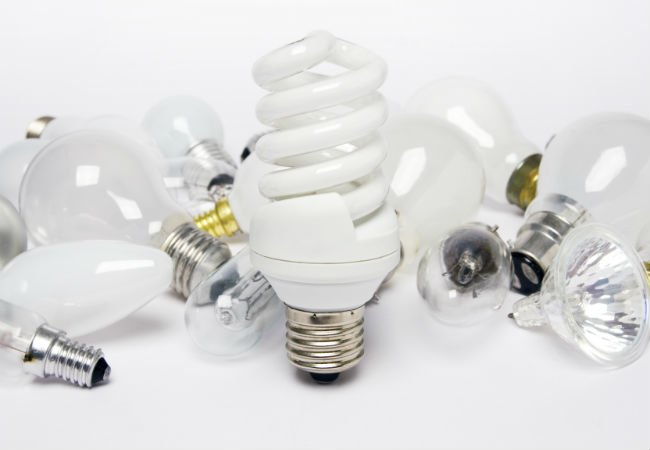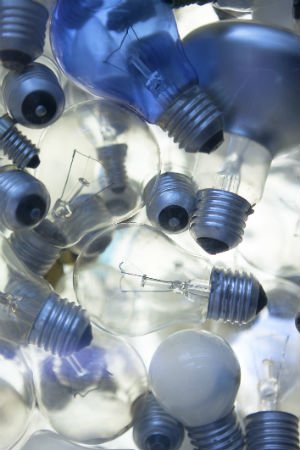

We may earn revenue from the products available on this page and participate in affiliate programs. Learn More ›
If you recently set out to upgrade your home with more energy-efficient light bulbs, you’ve likely seen there’s a bigger selection of light bulb varieties available today than ever before, with some designed to last as long as 50,000 hours. Even the most enduring bulb will burn out eventually, however, and need to be tossed—along with those you seek to replace. Before you throw any into the trash, you should know that some popular light bulbs contain toxic components that are hazardous to human health and can negatively impact the environment. Keep reading to learn the how to dispose of light bulbs correctly, be they incandescents, halogens, or just about any other type of light bulb in your home. Now that’s seeing the light!
How to Get Rid of Incandescent Light Bulbs
Incandescent light bulbs, the old standby we relied on for our reading lamps and overhead fixtures since the early 1900s, are slowly being edged out by higher efficiency versions. They typically only burn for 700 to 2,000 hours, and you can still find some lower-wattage incandescent bulbs on store shelves. They contain a wire filament in a thin, sealed glass bulb, but no toxic chemicals, so these bulbs can be safely thrown away in your regular household waste (not recycling, because the tiny wire filaments are too difficult to remove during the glass recycling process). They are fragile, however, and if they break, the sharp glass could puncture a plastic garbage bag, posing a risk of injury to you or to a sanitation worker. Whether yours has burnt out or is phasing out for a more energy-efficient model, be sure to slip a burned-out incandescent bulb into another type of disposable packaging, such as a used cereal box, before putting it in the trash.

How to Get Rid of Halogen Light Bulbs
Similar to incandescent bulbs, halogen bulbs contain wire filaments, which are sealed under pressure in thick, high-silica glass bulbs. They are an advanced type of incandescent bulb and can be used in standard lighting fixtures, designed for both indoor and outdoor use. Halogen bulbs, which last 2,000 to 4,000 hours, can be disposed of in your regular household waste (their fine wires prevent them from being recyclable). While halogen bulbs are less likely to break than incandescent bulbs due to the thicker glass, it’s still wise to place them in another type of disposable packaging before tossing them out.
How to Get Rid of LED Light Bulbs
Quickly becoming the energy-efficient bulb of choice in American homes, light-emitting diodes (LEDs) create light by sending electrons through a semiconductor material, triggering a process known as “electroluminescence,” which is similar to the way a laser works. They not only provide long-lasting illumination of 35,000 to 50,000 hours and use a fraction of the energy their incandescent predecessors do, LED bulbs are also safe to dispose of in your household waste. To date, no national LED recycling regulations or initiatives exist, but if you’d prefer to recycle, contact your local recycling center to see if they take LEDs. You can also search online for an LED recycler, such as HolidayLEDs, which accepts used LED Christmas lights at no charge (except shipping).
Recycling is becoming more popular, and because LEDs do not contain the fine wires that prevent the recycling of incandescent and halogen varieties, you’re likely to see more LED recycling options in the future. Until then, if you can’t find a convenient drop-off spot, rest assured that LEDs will not release harmful toxins into the environment if chucked in your regular trash.
How to Get Rid of Fluorescent Tube Lighting
These long tubes are energy efficient and long-lasting (a typical fluorescent bulb lasts 24,000 to 36,000 hours), making them favorites for workshops and other areas where bright, inexpensive lighting is desired. However, fluorescent tubes contain mercury—an environmental toxin—and should not be thrown out with ordinary household waste. In fact, as of 2018, recycling fluorescent tubes is the law in California, Maine, Massachusetts, Minnesota, New Hampshire, Vermont, and Washington, and more states are bound to follow with these regulations. Fortunately, many home improvement stores like Home Depot and Lowe’s, along with other major retailers, offer fluorescent recycling collection stations where consumers can drop off their old tubes free of charge. Visit Earth 911 and enter “fluorescent tubes” and your zip code to find a list of collection sites near you.
Disposing of a broken fluorescent tube requires extra care, since a small amount of mercury vapor escapes when the tube breaks. If you must dispose of a broken fluorescent tube, follow the steps below for the safe clean-up and disposal of CFLs.
How to Get Rid of CFLs
Easily identifiable by their narrow glass tubes, twisted into curlicue shapes, compact fluorescent bulbs (CFLs) fit into standard light fixtures and last 8,000 to 20,000 hours. Like fluorescent tubes, CFLs contain trace bits of mercury and should be recycled, never dumped in the regular trash. Visit Earth 911 and enter “CFLs” and your zip code for locations of local collection centers. You can also find mail-in programs online; they send out disposal kits with a pre-addressed container in which you can safely mail your old CFLs (they run anywhere between $30 and $70, depending on how many CFLs they hold).
CLEAN-UP AND DISPOSAL OF BROKEN CFLs
If you drop a CFL bulb and break it, the United States Environmental Protection Agency recommends the following safe disposal method:
- Send everyone (including pets) out of the room and air the room out for 10 minutes.
- Turn off your HVAC system to keep from circulating potentially toxic mercury vapor.
- Do not vacuum, which could distribute mercury vapor in the room.
- Use stiff paper, such as an index card to scoop up the broken bits of glass and powder residue, and dispose of it in a plastic bag or a glass jar.
- Use the sticky side of duct tape to lift any residual tiny bits of glass or powder from the surface.
- Use disposable wet wipes or damp paper towels to wipe the area clean and place wipes in the plastic bag or glass jar along with the broken glass and used duct tape.
- Contact your local waste authority or check the Earth 911 to locate a collection station near you.
If your state or community does not regulate the disposal of CFLs, and no recycling center is handy, the EPA suggests putting a used (or broken) CFL in a plastic bag and then putting it in your outside trash can for pickup.
